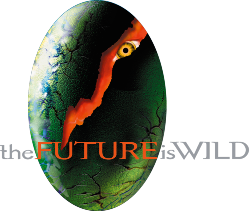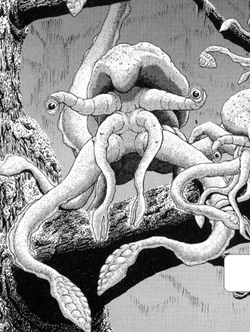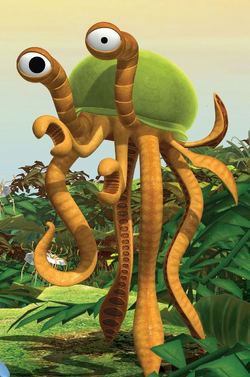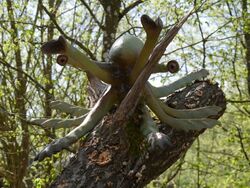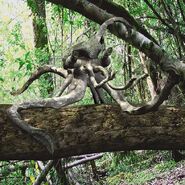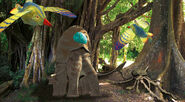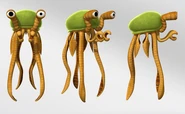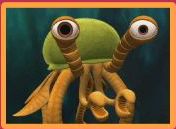| This article is about the species. For the animated series character, see Squibbon (character). |
| Squibbon Temporal range: 200 million AD | |
|---|---|
| Scientific classification | |
| Kingdom: | Animalia |
| Phylum: | Mollusca |
| Class: | Cephalopoda |
| Gallery | |
| “ | While the ability to operate tools and act communally reflects an intelligence ideally suited to life in the Northern Forest, it may be that a changing environment will encourage the development of even greater sophistication. Perhaps a reasoning type of intelligence will evolve once again.
|
” |
The squibbon is a species of arboreal terasquid endemic to the Northern Forest on the northwestern coast of Pangaea II, in 200 million AD. Primarily moving by a unique form of somersaulting brachiation, its muscular limbs and boneless body make it a highly flexible and agile acrobat, allowing it to live almost exlusively in the rainforest canopy. Squibbons are highly social, living together in close-knit "communes," and practice limited tool use; as the most intelligent and social animals on the planet since the extinction of humans, they may develop recognisable culture, society, and civilisation in the far future, possibly going on to dominate the planet as humans did before them.
Evolution[]
- Main article: Terasquid#Evolution
In the arrival of the 100 million AD mass extinction, the terasquids evolved to take advantage of the niches left empty by many animals. The squibbon fills the niches of brachiating animals and small, swift arboreal hunters.
In the future, squibbons may evolve greater intelligence, and perhaps even a civilisation. They are already capable of using tools and even weapons, and are highly intelligent, so it is possible that a change in the squibbon's environment may lead to it developing even further.
Biology[]

A squibbon surveys its territory with its stalked eyes.
Their torso is small and vaguely oval-shaped, and, as with regular squid, they have eight long, flexible legs and two pairs of smaller tentacles. These two tentacles are equipped with highly developed suckers or suction cups, which form highly flexible fingerlike or pincerlike protuberances. Their eyes are set on muscular, flexible stalks.
Squibbons are the most agile of the terasquids, and, with no skeleton to hinder their movement, are far more effective "swingers" than Human era animals such as gibbons. Unlike gibbons, they do not brachiate, swinging one arm after the other: instead, they loop end-over-end in a continuous somersaulting action, keeping their stalked eyes level with the body's centre of gravity as they do so, ensuring they are always looking towards the next branch. Their large brains and sharp vision enables them to navigate the forest canopy at high speeds.
Behaviour[]
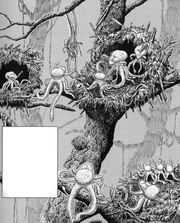
A squibbon colony in their nests.
Highly social animals, squibbons live in family communes and build simple, nest-like structures in the uppermost stories of the forest. They are the most intelligent animals of 200 million AD, with complex and close family bonds and social structures. Like humans before them, squibbons are capable of using tools, young squibbons learn by playing, and the colony is quite capable of working together as a whole community.
Squibbons are omnivorous and feed mainly on plants, fruits, and lichen pods, but they may also eat small animals which they catch with their tentacles. Young squibbons sharpen their senses and coordination by chasing other animals.
The suction cups on a squibbon's tentacles form fingerlike protuberances which are so flexible that a squibbon can manipulate small objects and even use simple tools. They have even developed the use of weapons to some degree, as they will sometimes branish branches as clubs, and use fruits and lichen pods as thrown projectiles.
Ecology[]
Omnivores, squibbons will eat both small animals such as forest flish, and fruits like those of the lichen tree, in which they may also built nests. Chasing animals such as flish can sharpen the senses and coordination of squibbons.
Careless squibbons may end up caught by similarly-omnivorous megasquid, but the colony will always defend their own by harassing the megasquid with fruits and spore polyps, or swinging down and rescuing the endangered squibbon. They may also fall prey to slithersuckers.
Appearances[]
In the documentary[]
In "The Tentacled Forest", a party of squibbons is awoken at dawn by a passing megasquid. Whilst they play, the megasquid grabs one of the babies. The family groups together to mob the megasquid with lichen tree capsules, and they manage to rescue the baby.
In the manga[]
"Northern Forest," the manga's final chapter, follows a colony of squibbons. They manage to repel a megasquid, and afterwards two squibbons play together with a bioluminescent organism and contemplate the stars. The next day, during a foggy rainstorm, the megasquid attacks again, and, although the colony severely harasses it and even trips it up with a makeshift "rope," it eats one of these two squibbons. The surviving squibbon becomes depressed, but is cheered up by the rest of the colony, who gather with hundreds of the bioluminescent organisms.
In the animated series[]
Major appearances[]
- Main article: Squibbon (character).
Squibby, a pet squibbon, appears in every episode of the the animated series The Future Is Wild. Other squibbons appear in "Sweet Home Pangaea II", "Queen of the Squibbons, Part 1", and "Queen of the Squibbons, Part 2". Six squibbons, Uli, Rondo, Zet, Oqnga, Oqtz, and Buzzy, are named.
In "Sweet Home Pangaea II," Squibby escapes from the Time Flyer and meets a group of wild squibbons—Uli, Rondo, and Zet—who are surprised that he cannot hunt flish, but are impressed by his juggling abilities. When Emily is caught by a megasquid, Squibby and the wild squibbons rescue her.
In "Queen of the Squibbons, Part 1" and "Queen of the Squibbons, Part 2," Emily looks after a baby squibbon named Buzzy, who was orphaned in a megasquid attack. Whilst she is stranded in the Northern Forest, two wild squibbons, Oqnga and Oqtz, help her to manage her treehouse and draw water in exchange for food, but, like Squibby, they take an initial dislike to Buzzy. In the end, Buzzy's parents return for him.
Behind the scenes[]
Criticism[]
As with all the other squids in the series, the squibbon is a controversial topic. Arguments include that branch slips and falling from trees would be fatal without the presence of an endoskeleton.
List of appearances[]
- The Future is Wild
- 1x01. Welcome to the Future
- 1x13. The Tentacled Forest
- The Future Is Wild: A Natural History of the Future
- The Future is Wild manga
- 08. Northern Forest
- The Future Is Wild animated series
- 1x01. The Electric Fisherman
- 1x02. Extreme Bird Watching
- 1x03. Sky High Anxiety
- 1x04. Toratonnage
- 1x05. Think Big
- 1x06. Squibbon See, Squibbon Do
- 1x07. A Poggle's Not a Pet...Yet
- 1x08. Phantom Fear
- 1x09. The Future Is Underground
- 1x10. Be True to Your Crew
- 1x11. Sign of the Time Flyer
- 1x12. De-Tour de France
- 1x13. Night Crawlers
- 1x14. Sweet Home Pangaea II
- 1x15. Shallow Pals
- 1x16. Parent Trap
- 1x17. Around the World In 80 Minutes
- 1x18. Monkey Brains
- 1x19. Swimming With Slickribbons
- 1x20. Scared Safe
- 1x21. He Might Be Giant
- 1x22. Ghost in the Machine
- 1x23. Cure For The Common Megasquid Cold
- 1x24. Queen of the Squibbons, Part 1
- 1x25. Queen of the Squibbons, Part 2
- 1x26. Snowstalker in a Strange Land
- The Future Is Wild: The Living Book
Notes[]
- The name "squibbon" is a portmanteau of "squid" and "gibbon". Gibbons are the fastest and most agile of arboreal mammals, as shown in stock footage in "The Tentacled Forest".
- The squibbon is the final organism presented in The Future Is Wild.
- Alongside several other animals from The Future Is Wild, the squibbon was redesigned for its appearance in the 2009 version of Les Animaux du Futur at the Futuroscope. Reflecting its French name, pieuvre-singe ("monkey-octopus"), the 2009 version of the squibbon was more octopus-like in form, with a plumper body, slimy glandular skin, and catfish-like tendrils around its mouth.
- A squibbon was featured in an augmented reality computer programme created to promote Les Animaux du Futur. The programme, one of two released on the attraction's website, used the computer's webcam to generate a squibbon on top of the user's head. As the website has since been shut down, the programme can no longer be downloaded.
- The evolution of the squibbon is presented as a case study in contingency in the book Ethical Marxism: The Categorical Imperative of Liberation (2013) by Bill Martin. Martin writes that the squibbons may one day "establish a global community of mutual flourishing," something humans failed to do before their extinction within the The Future Is Wild universe.
- Speculative evolution blogger Sigmund Nastrazzurro has coined the term "cernuation" to refer to the squibbon's method of locomotion through the treetops.[1]
Gallery[]
In other languages[]
| Language | Name | Translation |
|---|---|---|
| Czech | Houpavka | Contains the Czech verb houpat se ("to swing") |
| French | Pieuvre-singe | "Octopus-monkey" |
| German | Kletterkalmar | "Climbing squid" |
| Japanese | Sukuibon (スクイボン) | Transcription of English name |
| Spanish | Calabón | Portmanteau of calamar ("squid") and gibbon |
References[]
[]
| |||||||||||
- ↑ Nastrazzurro, Sigmund (7 July 2010) "To Cernuate or Not to Cernuate... (Cernuation III)" Furahan Biology and Alied Matters. Accessed 24/10/2022
